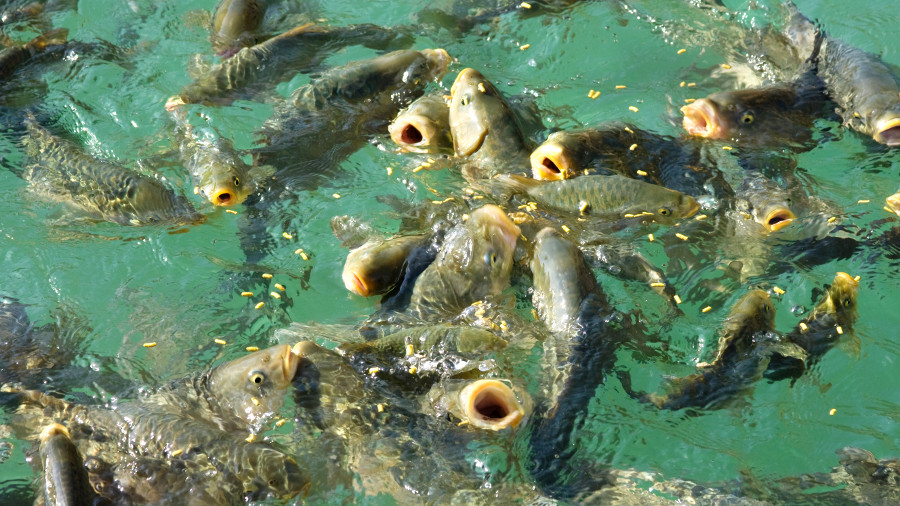
World Nutrition: Insects will be on every table
Bioeconomy:?It could be a turning point for the fish meal and fish oil dependent animal feed industry in Europe. Since July, the European Commission has allowed the use of insect-processed animal proteins for aquaculture. According to experts, the use of insect meal as a sustainable alternative opens an US$90bn market.
Imagine your dinner consists of beetles or worms. In Switzerland, insect-eating is now entering everyday life. However, nothing yet crawls on the plate. In August, Switzerland revised its food safety laws and began selling insect products, like burgers or balls made of insect flour, in its second-largest supermarket chain, Coop. But a much larger market is expected in animal breeding. Although the general European human population is not yet eager to introduce the crunchy and nutritious snacks into its diet, insects may soon become a promising source of high-quality, sustainable proteins as an add-on to fishmeal feed formulae for aquaculture. They are rich in proteins and lipids and have a very high content of unsaturated fatty acids, and dietary fiber in the form of chitin and minerals, such as iron or calcium. It makes them a serious alternative as a high-quality natural diet for fish feed and pet food and opens an estimated US$90bn market, states Antoine Hubert, president of the International Platform of Insects for Food and Feed (IPIFF).
In 2050, the world population is expected to reach nine billion people. According the Food and Agriculture Organisation of the United Nations (FAO), humanity will need up to 265 million tons of additional proteins per year. Probably the most exciting development in global nutrition of the future is the supply of high quality protein from algae, insects and microorganisms, states Prof. Hannelore Daniel, member of the German Bioeconomy Council, which recently published a background paper on alternative protein sources in the farming industry.
Low footprint guaranteed
Insects are abundantly available, with a high nutritional value and a tiny ecological footprint. They can offer a valuable and sustainable addition to soybean and fishmeal – the most common protein sources for aquaculture and livestock. In comparison to other livestock, insects are relatively easy to breed and rear. According to industry experts, even on large production scales, they dont need hormones or antibiotics to grow fast or fend off infectious diseases. Some species, like the black soldier fly, can also be fed with organic waste products, such as farming or food waste. Besides that, excrement from the insects can be used as a fertilizer in farming. Larvae require little space and consume low water levels. Furthermore, insects are very efficient in transforming feed into proteins: they need two kilograms of feed to produce one kilogram of mass. In comparison, cattle require 8 kg biomass to produce 1 kg of body weight gain.
Concerning the use of insect proteins as animal feed, Europe has reached an important milestone. Since July, the European Commission has allowed the use of insect-processed animal proteins (PAPs) for aquaculture animals. The green light for the fishing industry is absolutely a huge step forward for the insect industry. It gives insect protein producers high visibility for potential investors for the first time, says Hubert. The future promise of the insect farming industry was underscored by the recent €45m in funding received by Netherlands-based insect company Protix in June – the largest investment in the nascent European insect farming industry to date.
In 2009, Protix started their business by developing the first technologies to breed insects. Focusing on scalability and quality, the technologies they devised enabled the industry to take off. The two former McKinsey & Company colleagues and Protix founders, Kees Aarts and Tarique Arsiwalla, built the first demo plant in the Netherlands for producing processed insect proteins, a type of PAP. With current technologies, the whole development chain – from rearing to separation and extraction of proteins – can be run automatically and produce large volumes of insect meal. Protix farms insects predominantly to produce animal and aquaculture feeds – including specialty feeds for pigs, poultry, and pets – and exports its products to more than 12 countries. Its four products are all derived from the black soldier fly. In September, they also acquired the Dutch company Fair Insects BV and diversified their portfolio by adding mealworms, crickets, and locusts.
Reaching the next scale
 At the beginning of this year, Protix created a joint venture with Switzerland-based food technology group Bühler named Bühler Insect Technology Solutions. Bühler has developed technologies for milling, one of the key process steps for extracting proteins from insects, drawing upon their more than 150 years of experience in developing scalable, hygienic plants and processes for food and feed products. The VC is established in Switzerland and has manufacturing plants in Asia, because of the region’s long-standing tradition of using insects in the animal industry, and lower barriers to consumer acceptance of insect-based food products. Initially the focus of the VC will remain on larvae of BSF.
At the beginning of this year, Protix created a joint venture with Switzerland-based food technology group Bühler named Bühler Insect Technology Solutions. Bühler has developed technologies for milling, one of the key process steps for extracting proteins from insects, drawing upon their more than 150 years of experience in developing scalable, hygienic plants and processes for food and feed products. The VC is established in Switzerland and has manufacturing plants in Asia, because of the region’s long-standing tradition of using insects in the animal industry, and lower barriers to consumer acceptance of insect-based food products. Initially the focus of the VC will remain on larvae of BSF.
Current legislations
In many European countries, animal proteins have been banned from use in livestock feeds since 1994, due to the mad cow disease crisis triggered by the spread of bovine spongiform encephalopathy (BSE). A legal framework for the use of insect-based feed has consequently yet to be created. In July, the European Commission partially lifted the so-called feed ban rules regarding the use of insect-processed animal proteins for aquaculture animals. The authorisation is, however, limited to seven insect species: black soldier fly, house fly, yellow mealworm, lesser mealworm, house cricket, banded cricket, and field cricket. Insects kept in the EU for the production of food, feed, or other purposes are considered farmed animals governed by the general EU feed rules. As a consequence, insects cannot be fed with particular materials, such as slurry or manure, catering waste, or processed former foodstuffs containing meat or fish. Right now, proper communication and guidelines for farming and processing standards in Europe need to be the next steps concerning the use of insect protein in fish feed, states Hubert. IPIFF was launched in 2015, combining forces from 40 members of the insect-producing industry from the Netherlands (e.g. Protix, Proti-Farm), France (e.g. Ynsect, Entomo Farm, NextAlim, Micronutris), Germany (Hermetia) and Poland (Hipromine).
Crunchy diet for Europe’s plates
Although about 1,500 species of insects are consumed in more than 100 countries worldwide, in Europe, they are still very little accepted and food and insect-eating is still in a legal gray zone. But at the beginning of 2018, a new EU regulation will come into force and ensure clarity. Insects will then be recognised as novel foods and need will have to undergo a centralised assessment and authorisation procedure by the European Food Safety Authority.
(First published in European Biotechnology, Autumn Edition 2017)


 Pharmahungary Group
Pharmahungary Group Sofinnova Partners
Sofinnova Partners VFA
VFA